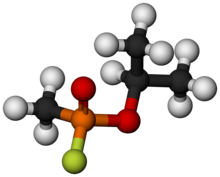
Back سارين Arabic Sarín AST Zarin Azerbaijani سارین AZB Зарын Byelorussian Зарын BE-X-OLD Зарин Bulgarian Sarin BS Sarín Catalan Sarin Czech

| ||

| ||
| Names | ||
|---|---|---|
| Pronunciation | /ˈsɑːrɪn/ | |
| Preferred IUPAC name
(RS)-Propan-2-yl methylphosphonofluoridate | ||
| Other names
(RS)-O-Isopropyl methylphosphonofluoridate; IMPF;
GB;[2] 2-(Fluoro-methylphosphoryl)oxypropane; Phosphonofluoridic acid, P-methyl-, 1-methylethyl ester | ||
| Identifiers | ||
3D model (JSmol)
|
||
| ChEBI | ||
| ChEMBL | ||
| ChemSpider | ||
PubChem CID
|
||
| UNII | ||
CompTox Dashboard (EPA)
|
||
| ||
| Properties | ||
| C4H10FO2P | ||
| Molar mass | 140.09 g·mol−1 | |
| Appearance | Clear colourless liquid, brownish if impure | |
| Odor | Odourless in pure form. Impure sarin can smell like mustard or burned rubber. | |
| Density | 1.0887 g/cm3 (25 °C) 1.102 g/cm3 (20 °C) | |
| Melting point | −56 °C (−69 °F; 217 K) | |
| Boiling point | 158 °C (316 °F; 431 K) | |
| Miscible | ||
| log P | 0.30 | |
| Hazards | ||
| Main hazards | Extremely lethal cholinergic agent. | |
| NFPA 704 |
| |
Except where otherwise noted, data are given for materials in their standard state (at 25 °C [77 °F], 100 kPa). | ||
| Infobox references | ||
Sarin (or GB) is a nerve gas, a deadly poison. It was developed as a chemical weapon for use in war by Nazi Germany.
It is classified as a weapon of mass destruction in UN Resolution 687.[3] Production and stockpiling of sarin was outlawed by the Chemical Weapons Convention of 1993, and it is classified as a Schedule 1 substance according to the convention. That means that is a very dangerous chemical that has no use outside of chemical warfare.
Sarin can be lethal even at very low concentrations. Death comes in 1 to 10 minutes after breathing it in. It paralyses lung muscles. Antidotes, such as atropine, can save a person if given immediately.[4] People who get a non-lethal dose, but do not get immediate treatment, may suffer permanent neurological damage.
- ↑ "Material Safety Data Sheet -- Lethal Nerve Agent Sarin (GB)". 103d Congress, 2d Session. United States Senate. May 25, 1994. Retrieved November 6, 2004.
- ↑ "Sarin". National Institute of Standards and Technology. Retrieved March 27, 2011.
- ↑ "Chemical weapons 101: Six facts about sarin and Syria's stockpile". CS Monitor. 21 August 2013.
- ↑ Sarin (GB). Emergency Response Safety and Health Database. National Institute for Occupational Safety and Health. Accessed April 20, 2009. [1]
